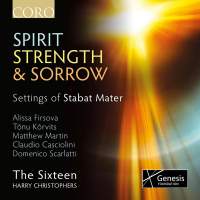Texte paru dans: / Appeared in: |
|
|
Outil de traduction (Très approximatif) |
|
|
|
|
|
Reviewer: J.
F. Weber The chant setting heard here is the sequence assigned to September 15, recorded over 20 times already. Casciolini only set alternate verses of the sequence, using the chant melody for the rest. The other three settings are all different. Alissa Firsova (the youngest of the three contemporaries) sets only seven strophes, while Tönu Körvits sets 12. Matthew Martin, coming from the Anglican tradition, alternates seven strophes with new poetic texts by Robert Willis and divides the whole into a “Passiontide Triptych.” He also incorporates the hymn tune, more familiar than the sequence in devotional use, into his setting. Martin’s setting is by far the most original of the three. The Scarlatti setting is by far the longest work in this collection, a brilliant work that is particularly suitable to 10 solo voices with basso continuo (here, theorbo, harp, and organ). The work ends with a brilliant fugue on “amen.” The previous version of choice came from Eric van Nevel ( Fanfare 15:2), and Rinaldo Alessandrini is also fine (31:5), but anyone who missed those will want to hear this. This is one more example of Harry Christophers in his wide-ranging attention to early and modern music in tandem. | |
|
|
|
|
Cliquez l'un ou l'autre
bouton pour découvrir bien d'autres critiques de CD |
|




